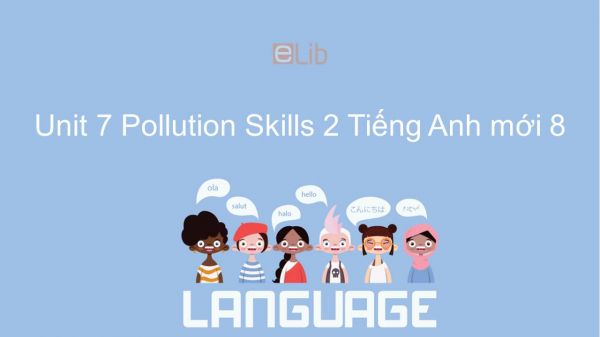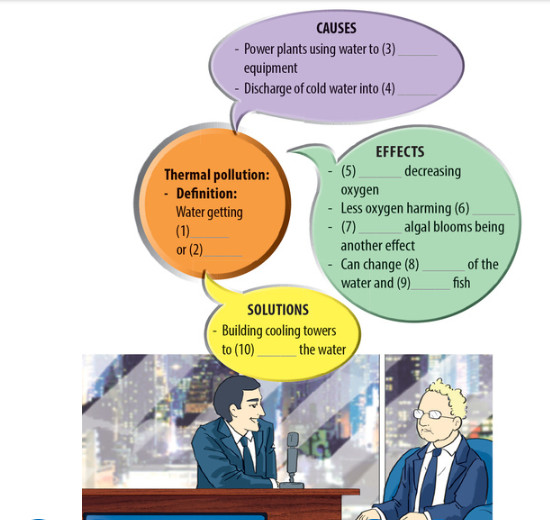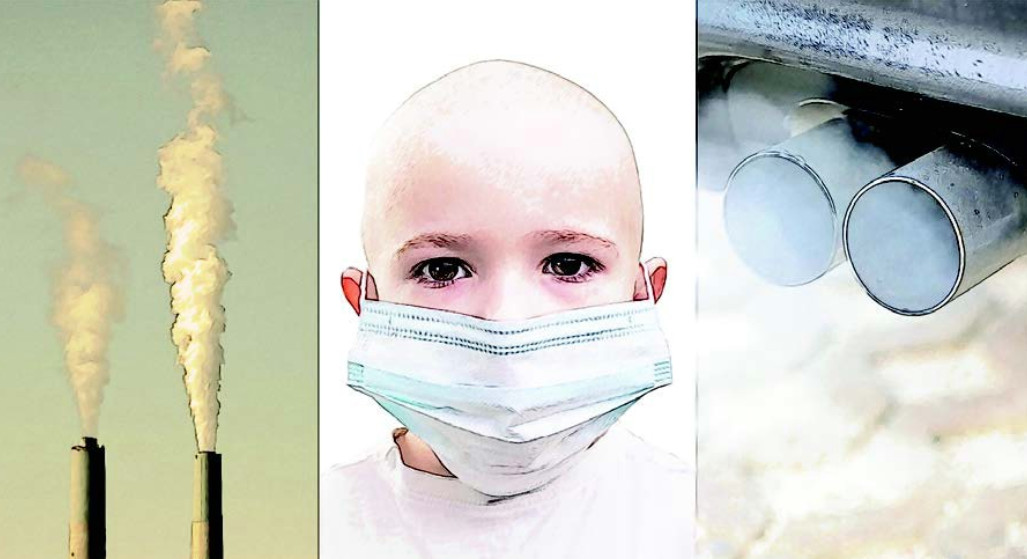Unit 7 lớp 8: Pollution - Skills 2
Phần Skills 2 - Unit 7 giúp các em luyện tập hai kĩ năng chính là Listening và Writing. Bài học cung cấp một đoạn hội thoại về sự ô nhiễm nhiệt và hướng dẫn các em viết về một loại ô nhiễm với nguyên nhân, hậu quả của nó và đưa ra giải pháp cho loại ô nhiễm đó.
Mục lục nội dung

1. Listening
1.1. Task 1 Unit 7 lớp 8
Describe what you see in the pictures and talk about the relationship between them. (Miêu tả những gì em xem trong hình và nói về mối quan hệ giữa chúng.)
Click to listen

Guide to answer
- The first picture shows an algal bloom in coastal seawater.
(Hình ảnh đầu tiên cho thấy sự nở hoa của tảo trong nước biển ven bờ.)
- The second picture shows the cooling towers from a power station.
(Hình ảnh thứ hai cho thấy các tháp làm mát từ một trạm điện.)
- They are both related to thermal pollution.
(Cả hai đều liên quan đến ô nhiễm nhiệt.)
1.2. Task 2 Unit 7 lớp 8
Listen to part of a conversation on TV between a reporter and an environmentalist about thermal pollution. Complete the diagram. Use no more than three words for each blank. (Nghe phần bài thoại trên ti vi giữa một phát thành viên và nhà môi trường học về ô nhiễm nhiệt. Hoàn thành bảng biểu. Sử dụng không hơn 3 từ cho mỗi chỗ trống.)
Click to listen

Guide to answer
(1) hotter
(2) cooler
(3) cool
(4) warm rivers
(5) warm water
(6) fish populations
(7) harmful
(8) colour
(9) poison
(10) cool down
Tạm dịch:
Ô nhiễm nhiệt
- Định nghĩa: nước nóng hơn hoặc mát hơn Nguyên nhân:
+ Nhà máy nhiệt điện sử dụng nước để làm mát thiết bị.
+ Thải nước nóng vào những dòng sông.
- Hậu quả:
+ Nước nóng hơn làm giảm lượng ôxi.
+ Ít ôxi làm hại đàn cá.
+ Sự phát triển của những tảo gây hại cũng là hậu quả khác.
+ Có thể thay đổi màu sắc của nước và gây ngộ độc cá.
- Giải pháp:
Xây dựng những tháp làm mát để làm nguội nước.
Audio script:
Reporter: Does thermal pollution mean that bodies of water get hotter, Mr Nam?
Mr Nam: Not always. Sometimes the water becomes colder, and that’s also thermal pollution means a change in the water temperature.
Reporter: That’s interesting! What cause is it?
Mr Nam: Power stations are one factor. They use water in the nearby lakes or rivers to cool their equipment, which heats up the water. Then they dump the hot water back into its source.
Reporter: Are there any other causes?
Mr Nam: Yes. Thermal pollution may also happen due to the discharge of cold water from reservoirs into warm rivers.
Reporter: Thermal pollution can have dramatic effects. Right?
Mr Nam: Certainly. Most aquatic creatures need a certain temperature to survive. Warmer water has less oxygen in it, and this can harm fish populations. Besides, warmer water can cause harmful algal blooms. This can change the colour of the water like in the first picture and, more seriously, the algea poisons the fish.
Reporter: What can we do, Mr Nam?
Mr Nam: In many places, they build cooling towers like in the second picture to cool down the water from power stations.
Reporter: Anything else we can do?...
Tạm dịch:
Phóng viên: Ô nhiễm nhiệt có phải làm các nguồn nước nóng lên không, ông Nam?
Ông Nam: Không hoàn toàn đúng. Đôi khi nước trở nên lạnh hơn, và điều đó cũng làm ô nhiễm nhiệt nghĩa là thay đổi nhiệt độ nước.
Phóng viên: Thật thú vị! Nguyên nhân là gì vậy?
Mr Nam: Nhà máy điện là một yếu tố. Họ sử dụng nước ở các hồ hoặc sông gần đó để làm mát thiết bị của họ, làm nóng nước. Sau đó, họ đổ nước nóng trở lại nguồn của nó.
Phóng viên: Có nguyên nhân nào khác không?
Ông Nam: Có. Ô nhiễm nhiệt cũng có thể xảy ra do việc xả nước lạnh từ các hồ chứa vào các con sông ấm.
Phóng viên: Ô nhiễm nhiệt có thể có tác động mạnh mẽ. Có đúng không?
Ông Nam: Chắc chắn rồi. Hầu hết các sinh vật thủy sinh cần một nhiệt độ nhất định để tồn tại. Nước ấm hơn có ít ôxy hơn, và điều này có thể gây hại cho quần thể cá. Bên cạnh đó, nước ấm hơn có thể gây ra tảo nở hoa có hại. Điều này có thể thay đổi màu sắc của nước như trong bức hình đầu tiên và, nghiêm trọng hơn, tảo đầu độc cá.
Phóng viên: Chúng ta có thể làm gì, ông Nam?
Ông Nam: Ở nhiều nơi, họ xây dựng các tháp làm mát như trong bức hình thứ hai để làm mát nước từ các nhà máy điện.
Phóng viên: Chúng ta có thể làm bất cứ điều gì khác không? ...
2. Writing
2.1. Task 3 Unit 7 lớp 8
Work in pairs. Discuss the causes and effect of one type of pollution in your area. Make notes in the diagram. (Làm theo cặp. Thảo luận những nguyên nhân và hậu quả của một trong những loại ô nhiễm trong khu vực em. Ghi chú vào biểu đồ.)
Guide to answer
Soil pollution
- Definition: Soil pollution happens when human activities destroy the earth’s surface.
- Cause: pesticides, herbicides, chemical industrial watse, deforestation...
- Effect: soil pollution, the upper layer of soil is damaged, effect on wild-life...
Tạm dịch:
Ô nhiễm đất
- Định nghĩa: Ô nhiễm đất xảy ra khi những hoạt động của con người phá hủy bề mặt trái đất.
- Nguyên nhân: thuốc trừ sâu, thuốc diệt cỏ, chất thải công nghiệp hóa chất, nạn phá rừng...
- Tác động: ô nhiễm đất, lớp đất mặt bị hư, tác động lên động vật hoang dã...
2.2. Task 4 Unit 7 lớp 8
Imagine that you two are writing an article for the local newspaper about a type of pollution in your area. One of you writes about the causes and the other writes about the effects of the pollution type you have just discussed in 3. (Tưởng tượng rằng em đang viết một bài báo cho một tờ báo địa phương về một loại ô nhiễm trong khu vực em. Một trong các bạn viết về nguyên nhân và những người khác viết về hậu quả, sau đó thảo luận.)

Guide to answer
Air pollution:
- Definition: Air pollution occurs when the air contains gases, dust, fumes or odour in harmful amounts
- Cause: industrial watse, exhaust from car and plane...
- Effect: causing diseases, death to humans, damage to other living organisms such as animals and food crops, or the natural or built environment.
- Solutions: Fine companies that release emissions into the air.
Tạm dịch:
Ô nhiễm không khí
- Định nghĩa: Ô nhiễm không khí xảy ra khi không khí chứa khí độc, bụi, khói hoặc mùi hôi với số lượng nguy hiểm.
- Nguyên nhân: chất thải công nghiệp, khí thải từ xe hơi và máy bay...
- Hậu quả: gây ra những căn bệnh, cái chết cho con người, gây hại đến quần thể sống như động vật và vụ mùa thực phẩm, hoặc môi trường thiên nhiên hoặc kiến trúc môi trường.
- Giải pháp: Phạt các công ty thải khí thải vào không khí.
2.3. Task 5 Unit 7 lớp 8
Read each other's work an put them together to make a complete article. (Đọc bài của mỗi người và đặt chúng cùng nhau để làm bài hoàn chỉnh.)
3. Practice Task 1
Choose the letter A, B, C or D to complete the sentences with given words
Question 1: If/ people/ breath/ contaminate/ air, they/ have/ breathing problems
A. If people breathed contaminated air, they had breathing problems.
B. If people breathed contaminated air, they would have breathing problems.
C. If people breath contaminated air, they have breathing problems.
D. If people breath contaminated air, they will have breathing problems.
Question 2: Many/ people/ this area/ have/ cholera/ because/ they/ drink/ untreat/ water.
A. Many people in this area have cholera because they drink untreated water.
B. Many people on this area have cholera because they drink untreated water.
C. Many people on this area have cholera because they drink untreating water.
D. Many people in this area have cholera because they drink untreating water.
Question 3: The street/ not/ look/ attractive/ because/ there/ be/ a lot of/ rubbish.
A. The street not look attractive because there’s a lot of rubbish.
B. The street not look attractive because there’re a lot of rubbish.
C. The street doesn’t look attractive because there’s a lot of rubbish.
D. The street don’t look attractive because there’re a lot of rubbish.
Question 4: The music club/ be/ make/ so/ much noise/ that/ the residents/ require/ them/ turn/ the music/ down
A. The music club is making so much noise that the residents require them to turn the music down.
B. The music club is make so much noise that the residents require them to turn the music down.
C. The music club be make so much noise that the residents require them to turn the music down.
D. The music club be making so much noise that the residents require them to turn the music down.
Question 5: Visual/ pollution/ prevent/ us/ see/ far/ away.
A. Visual pollution prevents us from seeing far away.
B. Visual pollution prevents us with seeing far away.
C. Visual pollution prevents us on seeing far away.
D. Visual pollution prevents us of seeing far away.
4. Practice Task 2
Rearrange the sentences to make meaningful sentences
Question 6: What/ pollution/ to/ is/ types/ the/ of/ most/ human/ harmful?
A. What pollution of types is the most harmful to human?
B. What types of pollution is the most harmful to human?
C. What the most types of pollution is harmful to human?
D. What is types of pollution harmful the most to human?
Question 7: poison/ Sewages/ lakes/ from/ such/ and/ water/ factories/ bodies/ as/ rivers
A. Sewages as rivers from factories poison water bodies such and lakes.
B. Sewages and lakes from factories poison water bodies such as rivers.
C. Sewages from factories poison rivers and lakes such as water bodies.
D. Sewages from factories poison water bodies such as rivers and lakes.
Question 8: of/ are/ Plastic/ of/ source/ the/ main/ bags/ one/ pollution.
A. Plastic bags are the one of main source of pollution.
B. Plastic bags are one of source of the main pollution.
C. Plastic bags are one of the main source of pollution.
D. Plastic of bags are one pollution of the main source.
Question 9: in/ food/ Soil/ results/ contamination/ unsafe
A. Soil food results in unsafe contamination.
B. Soil contamination results in unsafe food.
C. Soil unsafe results in food contamination.
D. Soil results in contamination unsafe food
Question 10: If there were more trees in the area, the air would be fresher.
A. If there were more trees in the area, the air would be fresher.
B. If were there more trees in the area, the air would be fresher.
C. If there would be more trees in the area, the air were fresher.
D. If the air were more trees in the area, there would be fresher.
5. Conclusion
Kết thúc bài học này, các em cần rèn luyện kĩ năng nghe và luyện tập viết về nguyên nhân, hậu quả của một loại ô nhiễm ở địa phương và đưa ra giải pháp cho loại ô nhiễm đó; đồng thời ghi nhớ các từ vựng có trong bài học sau đây:
- thermal pollution: ô nhiễm nhiệt
- power station: trạm năng lượng
- cool down: làm mát >< heat up: làm nóng
- fumes (n): khói
- industrial watse: rác thải công nghiệp
- living organisms: sinh vật sống
- discharge (n): xả
- temperature (n): nhiệt độ
- survive (v): sống sót
- seriously (adv): một cách nghiêm trọng
Tham khảo thêm
- doc Unit 7 lớp 8: Pollution - Getting Started
- doc Unit 7 lớp 8: Pollution - A Closer Look 1
- doc Unit 7 lớp 8: Pollution - A Closer Look 2
- doc Unit 7 lớp 8: Pollution - Communication
- doc Unit 7 lớp 8: Pollution - Skills 1
- doc Unit 7 lớp 8: Pollution - Looking Back
- doc Unit 7 lớp 8: Pollution - Project



